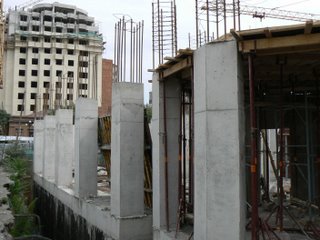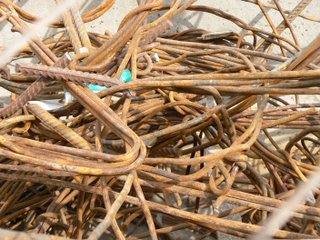
Many people are excited by all the construction going on in Central Yerevan. And depending who you speak to, they are enthusiastic or disgusted. As has been reported on this blog and various news sources, this construction has come at the expense of destroying most of Old Yerevan, the few remains of which can only be found in a few nooks and crannies on side streets, like Puskin and the beginning of Deryan, near Republic Square. If you look hard enough on foot, you can still find some structures with a pre-Soviet history—I bumped into a couple today.
Obviously people who are positive about what’s going on around them feel as though the change is for the better. There is a mentality among Armenians that anything old is inferior because of its age, which is why they are so quick to buy the latest cell phone model or newest German automobile. Slightly used is no longer good enough for Armenians who have some money to spend—they have to purchase brand new cars trucked in from Europe or flown in from Dubai. This goes for Armenians everywhere, by the way, it’s not unique to those living and born in Armenia. It makes sense why they are proud to see so many “pretty” buildings going up.
People I know who work in the real estate business told me that these buildings are for the most part being poorly built. I suspected as much just from observing from street level, but I was unable to pinpoint how the structures were actually being erected, until I went for a walk today along Pushkin Street, which intersects the emerging Northern Boulevard.
From what I have seen thus far, as verified by my trip on foot, all of these buildings are made from poured cement, reinforced with thin, iron rods. Note that I wrote cement—there is evidently no concrete being used in any of these buildings going up. No iron crossbeams are implemented to construct the frames, particularly in the high rise buildings, nine floors high or more. In the United States, walls are constructed from either wood or aluminum studs and lined with insulation, then plaster board to complete them. In Yerevan, as well as in the villages, walls are made out of cement cinder blocks or, if the constructor is splurging, tuf stone.

No attention is being paid to making these structures earthquake resistant from what I have seen by examining the newly laid foundations, made completely of poured cement. New building practices have long been applied in regions prone to earthquakes, at least in the US. Some high risers for instance in such areas are built on top of gigantic lead-rubber isolation bearings resting on the foundation, as an attempt to prevent the structures from crumbing since they can effectively roll back and forth. No such thing here. In case of an earthquake, people can count on tons of reinforced cement to protect them.

But this is the same problem that got Armenians into trouble in the 1988 earthquake. Then, as now, high-rise buildings were made of poor quality cement and other generally inferior materials. Tens of thousands died because the Soviets used absurd, highly unsafe building technology in a main fault zone. Unfortunately, architects and construction contractors are disregarding that fact. Instead of trucking in large cement panels to be assembled together like wooden toy blocks as was done on the good old days, they make the panels onsite, using wide metal or wood forms. Panels can be formed in any necessary shape, round or flat, so long as there’s enough cement to be had. Dozens of truck loads are brought in to Yerevan everyday. There are no cement factories nearby, so the stuff is delivered from as far away as Ararat.
The not-to-distant danger is that Yerevan is due for an earthquake, as was recently discussed at a press conference held by the Armenian Association of Seismically Safe Construction a few weeks ago. In 1679 a quake completely devastated the city, and the same is predicted to occur soon, with a death toll of 300,000.

Depending on which building you look at, the quality seems to vary, from poor to average. None of the incomplete buildings I have seen have impressed me as being constructed with high quality in mind. For a city whose residents are bent on implementing the latest “European standards” pertaining to anything home related, it is disturbing to see how shabbily new structures are built.

In the middle of all this chaotic construction, cement dust everywhere, sometimes so thick that you can barely breath, two ancient structures by Yerevan’s standards still stand. Why they are still there is beyond me—I suppose no one has gotten around to tearing them down yet, especially when they can barely finish what they’ve started.
Indeed, some of these buildings have been in the works for over a year, even two or more. The only excuse I can find for not building them quicker is that cement keeps running out. There is such a high demand for cement that the factories can’t keep up, despite the fact that both Mika and Multigroup conglomerates—which are also heavily involved in numerous real estate projects—are manufacturing it. The Northern Boulevard is slated to be completed by 2007, but something tells me potential residents as well as businessmen will have a much longer wait.

I have to concur that the fact Yerevan is building up is a positive sign. Construction is a natural manifestation of progress. But the building standards being implemented are poor, or arguably nonexistent—this is obvious to anyone who has any sense of how structures are constructed in the West, for example. They will not be safe, and will be unhealthy for living—the interiors of panel-manufactured apartment buildings are known for being extremely warm, close to suffocating, in summers, while being frigid during the winter months. Thus they absorb environmental temperatures very well. There is one slight cosmetic difference between most of the Soviet panel-manufactured and the new buildings—thin granite or tuf tiles, about 1/16-1/4 of an inch or so thick, are being affixed to the exterior cement walls. Other than that, they are being built exactly the same way. If you leave the city by car, you’ll notice dozens of half-constructed buildings from the Soviet era virtually identical in craftsmanship to what you see along the Northern Boulevard. The new buildings are pretty ugly as well—there is no style to them. Just plain, rectangular blocks. Two or three are nearly completed, but there is nothing characteristic about them. They actually look like office buildings that you would see along highways in the US or Europe. One in particular comes to mind on the corner of Tumanyan and Deryan.

As of the beginning of this year, one square meter of real estate was priced at $1,500 in Central Yerevan. Many of the new apartments are designed to be at least 100 square meters in area each, which means that, when completed, they would cost $150,000. And that is for an unfinished apartment, with no floors or walls—just cement, underfoot and overhead. Apparently most of the apartments have been reserved by Armenian diasporans. I only hope they know what they’re about to live in.











Comments
What concerns me are the warnings by the seismologists. They know much more than I do about earthquake proof buildings. Thicker concrete beams that these new buildings have may not translate into safer buildings. If a few of them snap then the whole building may come down.
Well the guy who bulds the complex goes to the chief architect of Yerevan and the mayor, pays the right amount of bribe those guys approve it, BECAUSE ALL THEY CARE ABOUT IS THEIR OWN ASS, and off we go to building a new unsafe building.
And if anybody in the city administration decided to actually do his job, he/she would be fired because the people higher up would not be able to earn any side bribe income, since all the bribe money is shared in top to bottom form.
Not being an architect by training, I think that when a capital of a nation state, or any city or town for that matter, is being renovated, the process and outcome of renovation depends for the most part on the level of professionalism, maturity, public-spiritedness, open-mindedness, and artistic culture of the national elite. In case of the construction boom in Yerevan, what outcome can we possibly expect from a ruling provincial Karabakhi clan and their nouveaux rich brown-nosers? Of course, Europhile or American-style concrete glass buildings untypical for the entire panorama and unique architectural design of Yerevan, built on the sites of destroyed old buildings after throwing impoverished people out.
For narrow-minded, self-centered, and profit-oriented municipal and state rulers, most of whom are not even Yerevatsis but have come from remote villages of Armenia and Nagorno-Karabakh, demolition of architectural history of the city is much easier, and less costly, that conservation. In this context, the destruction of the Youth Palace, among many older buildings, so dear to every Yerevantsi has accentuated the sheer idiocy, intrinsic provincialism, and unruly wealth hunger of the unelected, unpopular elite.
I hope that one day, with God’s help, these elites, who are being hated by the overwhelming majority of Armenians, too will be demolished the way they desecrate the beautiful face of my city.